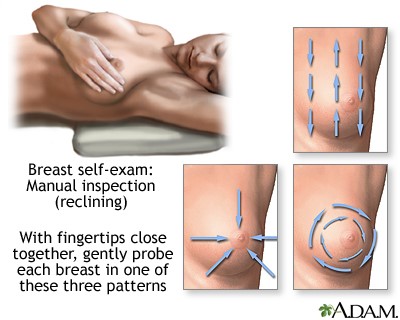This is the second most frequently diagnosed cancer in American women. All women can get breast cancer- even those with no family history. Regular self-breast exams will make you familiar with how they normally look and feel. The best time to do a monthly self-breast exam is about 3-5 days after your period starts because your breasts are not as tender or lumpy at this time in your monthly cycle. Perform the exam at the same time every month. If you have gone through menopause, do your exam on the same day every month.
To complete your own breast exam:
- Begin by lying on your back. It is easier to examine all breast tissue if you are lying down.
- Place your right hand behind your head. With the middle fingers of your left hand, gently yet firmly press down using small motions to examine the entire right breast.
- Next, sit or stand. Feel your armpit, because breast tissue goes into that area.
- Gently squeeze the nipple, checking for discharge. Repeat the process on the left breast.
- Use one of the patterns shown in the diagram to make sure you are covering all of the breast tissue.

- Next, stand in front of a mirror with your arms by your side.
- Look at your breasts directly and in the mirror. Look for changes in skin texture, such as dimpling, puckering, indentations, or skin that looks like an orange peel.
- Also note the shape and outline of each breast.
- Check to see if the nipple turns inward.
- Do the same with your arms raised above your head.
Report any changes to your healthcare provider.
Recommended Screening Schedule:
- Ages 40-49: Talk with your healthcare provider about when to start and how often to get a mammogram
- Ages 50-74 with an average risk for breast cancer: mammogram every two years
Follow your healthcare provider’s advice when deciding a screening schedule.
For more information visit the CDC Breast Cancer page.


Accommodations available upon request. Please contact 815-802-9400 Option 3 for more information.